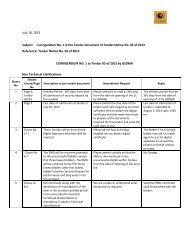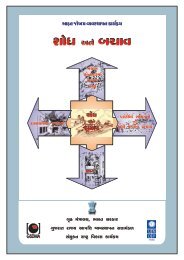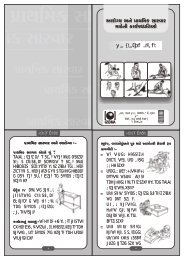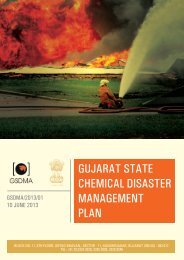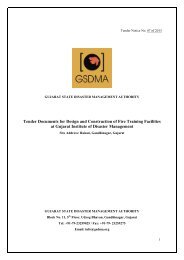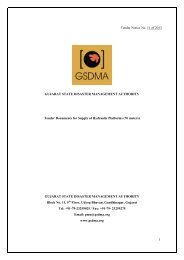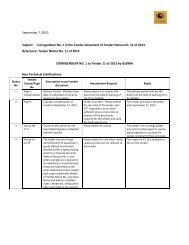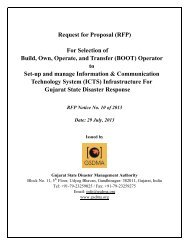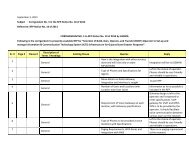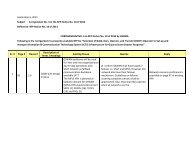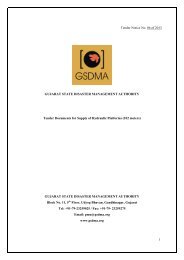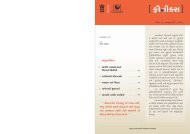Emergency Response Guidebook - Gujarat State Disaster ...
Emergency Response Guidebook - Gujarat State Disaster ...
Emergency Response Guidebook - Gujarat State Disaster ...
Create successful ePaper yourself
Turn your PDF publications into a flip-book with our unique Google optimized e-Paper software.
GUIDE155Substances - Toxic and/or Corrosive(Flammable/Water-Sensitive)ERG2012ERG2012Substances - Toxic and/or Corrosive(Flammable/Water-Sensitive)GUIDE155POTENTIAL HAZARDSFIRE OR EXPLOSION• HIGHLY FLAMMABLE: Will be easily ignited by heat, sparks or flames.• Vapours form explosive mixtures with air: indoors, outdoors and sewers explosion hazards.• Most Vapours are heavier than air. They will spread along ground and collect in low or confined areas(sewers, basements, tanks).• Vapours may travel to source of ignition and flash back.• Those substances designated with a (P) may polymerize explosively when heated or involved in a fire.• Substance will react with water (some violently) releasing flammable, toxic or corrosive gases andrunoff.• Contact with metals may evolve flammable hydrogen gas.• Containers may explode when heated or if contaminated with water.HEALTH• TOXIC; inhalation, ingestion or contact (skin, eyes) with Vapours, dusts or substance may cause severeinjury, burns or death.• Bromoacetates and chloroacetates are extremely irritating/lachrymators.• Reaction with water or moist air will release toxic, corrosive or flammable gases.• Reaction with water may generate much heat that will increase the concentration of fumes in the air.• Fire will produce irritating, corrosive and/or toxic gases.• Runoff from fire control or dilution water may be corrosive and/or toxic and cause pollution.PUBLIC SAFETY• CALL EMERGENCY RESPONSE Telephone Number on Shipping Paper first. If Shipping Paper notavailable or no answer, refer to appropriate telephone number listed on the inside back cover.• As an immediate precautionary measure, isolate spill or leak area in all directions for at least 50meters (150 feet) for liquids and at least 25 meters (75 feet) for solids.• Keep unauthorized personnel away.• Stay upwind.• Keep out of low areas.• Ventilate enclosed areas.PROTECTIVE CLOTHING• Wear positive pressure self-contained breathing apparatus (SCBA).• Wear chemical protective clothing that is specifically recommended by the manufacturer. It mayprovide little or no thermal protection.• Structural firefighters' protective clothing provides limited protection in fire situations ONLY; it is noteffective in spill situations where direct contact with the substance is possible.EVACUATIONSpill• See Table 1 - Initial Isolation and Protective Action Distances for highlighted materials. Fornonhighlighted materials, increase, in the downwind direction, as necessary, the isolation distanceshown under “PUBLIC SAFETY”.Fire• If tank, rail car or tank truck is involved in a fire, ISOLATE for 800 meters (1/2 mile) in all directions;also, consider initial evacuation for 800 meters (1/2 mile) in all directions.EMERGENCY RESPONSEFIRE• Note: Most foams will react with the material and release corrosive/toxic gases.CAUTION: For Acetyl chloride (UN1717), use CO2 or dry chemical only.Small Fire• CO 2, dry chemical, dry sand, alcohol-resistant foam.Large Fire• Water spray, fog or alcohol-resistant foam.• FOR CHLOROSILANES, DO NOT USE WATER; use AFFF alcohol-resistant medium expansion foam.• Move containers from fire area if you can do it without risk.• Use water spray or fog; do not use straight streams.Fire involving Tanks or Car/Trailer Loads• Fight fire from maximum distance or use unmanned hose holders or monitor nozzles.• Do not get water inside containers.• Cool containers with flooding quantities of water until well after fire is out.• Withdraw immediately in case of rising sound from venting safety devices or discoloration of tank.• ALWAYS stay away from tanks engulfed in fire.SPILL OR LEAK• ELIMINATE all ignition sources (no smoking, flares, sparks or flames in immediate area).• All equipment used when handling the product must be grounded.• Do not touch damaged containers or spilled material unless wearing appropriate protective clothing.• Stop leak if you can do it without risk.• A Vapour suppressing foam may be used to reduce Vapours.• FOR CHLOROSILANES, use AFFF alcohol-resistant medium expansion foam to reduce Vapours.• DO NOT GET WATER on spilled substance or inside containers.• Use water spray to reduce Vapours or divert Vapour cloud drift. Avoid allowing water runoff tocontact spilled material.• Prevent entry into waterways, sewers, basements or confined areas.Small Spill• Cover with DRY earth, DRY sand or other non-combustible material followed with plastic sheet tominimize spreading or contact with rain.• Use clean non-sparking tools to collect material and place it into loosely covered plastic containers forlater disposal.FIRST AID• Move victim to fresh air. • Call 108 or emergency medical service.• Give artificial respiration if victim is not breathing.• Do not use mouth-to-mouth method if victim ingested or inhaled the substance; give artificialrespiration with the aid of a pocket mask equipped with a one-way valve or other properrespiratory medical device.• Administer oxygen if breathing is difficult.• Remove and isolate contaminated clothing and shoes.• In case of contact with substance, immediately flush skin or eyes with running water for at least 20minutes.• For minor skin contact, avoid spreading material on unaffected skin.• Keep victim warm and quiet.• Effects of exposure (inhalation, ingestion or skin contact) to substance may be delayed.• Ensure that medical personnel are aware of the material(s) involved and take precautions to protectthemselves.Page 250Page 251



